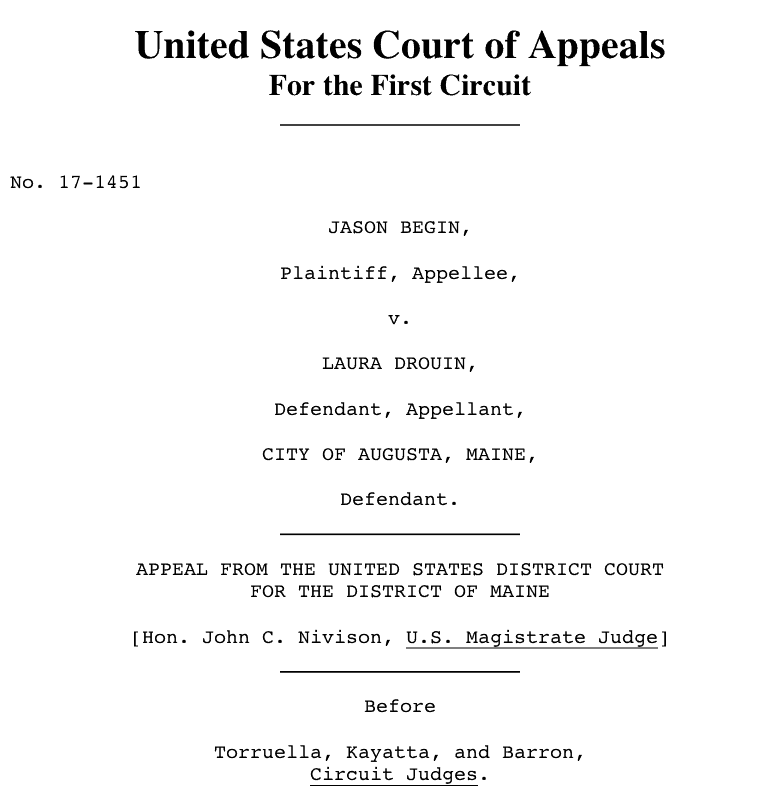Earlier this fall in Force Science News #374, we reported on the legal subtleties of responding to suicidal-subject calls and quoted Advanced Force Science Specialist Mike Ranalli as cautioning against taking impulsive aggressive action toward a subject “who isn’t committing a serious crime and isn’t an active threat to anyone other than himself.”
Now comes a case in point, decided in mid-Nov. by a federal Court of Appeals.
The subject in this instance was a 265-lb., mentally ill felon with “some history of violence” who was about to be returned to a locked psychiatric hospital after an unsuccessful trial stint at an outpatient group home in Maine. Anticipating that he’d be “upset” and uncooperative, his treatment team called a municipal officer to stand by outside the facility waiting room where he was to get the news.
Equipped with a sidearm, a TASER, an expandable baton, and pepper spray, the officer stayed out of sight with several hospital employees until she heard the subject declare that he was “not going back” to lockdown. Then, signaled by a team member, she stepped into the room and confronted him.
The subject stood up but made no attempt to move toward her. “Instead,” the court notes, “he reached into his pocket with his right hand; announced, ‘I should have done this moons ago’; pulled out a black folding knife; and brought it down hard on his left arm. He did not say anything to anyone as he slashed his arm.”
Instantly, the officer drew her gun and yelled, “Hey, hey, hey” in the suspect’s direction. As he “continued to cut at his arms”—making “no threats or movements towards anyone [else]”—the officer fired three rounds, hitting the subject twice in the chest and once in the shoulder. At that point, she later estimated at a hearing, “four to six seconds had passed since she first saw [him].” She stopped shooting when he fell to the floor, handcuffed him, and called for an ambulance.
The subject survived and about a year later brought a federal 1983 civil rights suit against the officer and her city, alleging that she violated his constitutional right to be free from unreasonable seizure when she shot him.
ADVERSE RULINGS
The officer’s attorney moved for a summary judgment in her favor on the ground of qualified immunity, claiming she reasonably believed the knife wielder had posed an “immediate threat” to her or the staff employees. But a District Court magistrate denied that motion, reasoning that the law was “clear that under the circumstances she could not constitutionally shoot [the suspect] unless he posed an immediate threat to herself or others and only after, if feasible, providing some kind of warning.”
Given the evidence, the magistrate explained, the case should be heard by a jury, which might “decide either way on the questions of whether (the subject) posed an immediate threat and whether a warning was feasible.”
On the officer’s appeal, a three-judge panel of the 1st Circuit US Court of Appeals agreed with the magistrate.
In its written ruling, the panel acknowledges that police officers are forced to make split-second decisions and “do not have the luxury of calmly considering the circumstances they face as if they were jurors or judges.”
Even so, the panel points out, the officer was at least 20 feet from the suspect when he drew the knife. He “could not have reached out and stabbed anyone first without advancing…toward the barrel of [the officer’s] raised gun,” and no one was between the two of them.
The subject “was intent on harming himself [but] threatened no one else by word or movement,” the panel says. Plus, “he had not received any warning or order” from the officer.”
Bottom line: The civil suit must forward.
The panel’s decision can be read in full at Begin v Drouin.
Our thanks to Atty. Michael Brave, director of CEW Legal for Axon Enterprise, Inc., for helping to facilitate these reports.


